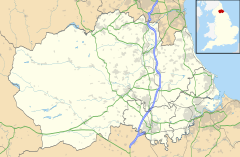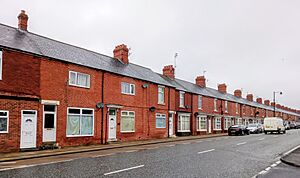Chilton, County Durham facts for kids
Quick facts for kids Chilton |
|
|---|---|
| Population | 3,744 (2011) |
| OS grid reference | NZ285295 |
| Unitary authority |
|
| Ceremonial county | |
| Region | |
| Country | England |
| Sovereign state | United Kingdom |
| Post town | FERRYHILL |
| Postcode district | DL17 |
| Dialling code | 01388 |
| Police | Durham |
| Fire | County Durham and Darlington |
| Ambulance | North East |
| EU Parliament | North East England |
| UK Parliament |
|
Chilton is a town located in County Durham, England. It's a short drive east of Bishop Auckland and south of Ferryhill, right next to the A167 main road.
History of Chilton
Chilton started as a mining village, once known as Chilton Buildings. The main mine was where the primary school stands today. Miners lived in nearby terraced houses, which were called Albert Street, Arthur Street, and Prospect Terrace. People often called them "The Five Rows" because of how they looked.
The name "Chilton" comes from old Anglo-Saxon words. "Cild" meant a young nobleman, and "Tun" meant a small town or estate. So, Chilton once meant "an estate belonging to a young nobleman." In medieval times, Chilton was actually split into two areas: Great Chilton and Little Chilton. Chilton Hall, a large house northeast of the town, was owned by the Heron family way back in 1351.
For many years, farming was the main job in Chilton. But when the Industrial Revolution began in the mid-1800s, things changed. People started working in coal mines or at steel factories in nearby Spennymoor.
St. Aidan's Church, which you can find at the top of Chilton, was first built from iron in 1877. Sadly, a fire destroyed it in 1928. It cost about £4,000 to rebuild, and it was finished in stone in 1930, thanks to Vicar Lancelot Wilkinson.
Life in Chilton Today
Chilton has a primary school called Chilton Primary. It teaches children from nursery all the way up to Year 6. After primary school, many students go to Ferryhill Business and Enterprise College for their secondary education.
The town has two churches: a Catholic church called Sacred Heart and the Anglican St. Aidan's Church. You'll also find a post office, a pub, and a Sports and Social Club. There's a Catholic club that also serves as a polling station during elections. For healthcare, there's an NHS health centre and a dentist.
Chilton also has a public library and two supermarkets. If you're looking for a quick meal, there's a fish and chip shop, a Chinese restaurant, and a pizzeria.
For sports and fun, Chilton has a football ground and a basketball court that lights up automatically at night. There are also play areas with swings, slides, and climbing frames, plus a skatepark. Buses run regularly, connecting Chilton to nearby towns like Ferryhill, Spennymoor, Durham, and even bigger cities like Hartlepool and Darlington.
Many people in Chilton enjoy gardening on their allotments. The town has over 200 allotments, which is a big community!
Changes and the Future
A new road, called a bypass, was built around Chilton in 2005. This bypass helps about 80% of traffic avoid driving through the town centre, making it quieter and safer. To build the bypass, some parts of West Chilton Terrace and the allotments had to be moved or changed.
Chilton officially became a town in 2000. This meant it got its own town council and a mayor. Even though it doesn't have some things you might expect in a town, like a bank or a butcher shop, it's still an important community.
In 2008, a new war memorial was built to remember the brave men from Chilton who lost their lives in the First and Second World Wars. Their names are carved into the stone memorial. Every year on Remembrance Sunday, there's a special ceremony. Veterans and local people gather to lay poppy wreaths and show their respect. At 11:00 AM, everyone observes two minutes of silence to remember the end of World War I, which happened at that exact time on November 11, 1918.
How Chilton is Governed
Chilton is part of an electoral ward (a local voting area) that shares its name. This ward also includes Ferryhill. In 2011, the total population of this ward was 8,647 people.



